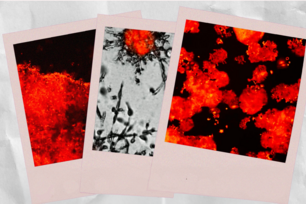Aggressive cancer exploits MYC oncogene to amplify global gene activity

c-Myc protein bound to DNA
AbsturZ (CC-BY-SA 3.0)
CAMBRIDGE, Mass. – For a cancer patient, over-expression of the MYC oncogene is a bad omen.
Scientists have long known that in tumor cells, elevated levels of MYC’s protein product, c-Myc, are associated with poor clinical outcomes, including increased rates of metastasis, recurrence, and mortality. Yet decades of research producing thousands of scientific papers on the subject have failed to consistently explain precisely how c-Myc exerts its effects across a broad range of cancer types. Until now, that is.
The prevailing theory emerging from this massive body of research has been that in tumor cells, c-Myc affects the expression of specific genes or sets of genes—that so-called Myc target genes are being selectively activated or repressed, leading to aberrant cellular behavior. Now, however, researchers in the lab of Whitehead Institute Member Richard Young are dispelling this commonly held notion, showing that elevated expression of c-Myc amplifies the activity of all expressed genes in tumor cells of multiple cancer types. It turns out that high levels of c-Myc send a tumor cell’s gene expression program into overdrive. Transcription increases dramatically, allowing malignant cells to overwhelm factors that might normally hamper their growth and proliferation. This surprising finding, published in this week’s issue of the journal Cell, provides a simple, elegant explanation for how a single protein can have such profound effect in so many and varied types of cancer. The newly revealed mechanism may also help scientists develop novel therapeutic approaches that disrupt c-Myc’s activity.
“MYC is a key driver in most major cancers, but it has been notoriously difficult to drug,” says Young, who is also a professor of biology at MIT. “Now that we know the mechanism by which c-Myc acts, we can go after the components of that mechanism as potential drug targets. This research creates an even stronger impetus to find a way to drug the thing.”
One potential drawback to thwarting c-Myc’s activity is the important role it plays in normal cell division. That role is so powerful that cells co-evolved an emergency death pathway to keep c-Myc expression in check. If c-Myc’s production spins out of control in an otherwise normal cell, the cell immediately commits suicide through a process called apoptosis. But in cancer cells in which c-Myc is overproduced, this suicide pathway is compromised, allowing the cell to survive and proliferate.
“MYC is the most deregulated gene in cancer,” says Charles Lin, a graduate student in the Young lab and co-author of the Cell paper. “It’s been called a bad-boy, a Swiss army knife, and a jack-of-all-trades because, according to previous research, it could do everything under the sun in a cancer cell. But most of the different attributes ascribed to MYC are contradictory or seemingly incompatible.”
Propelled by its earlier research that identified c-Myc as an important regulator of transcription in embryonic stem cells, the Young lab began to focus on c-Myc’s activity within cancer cells. Lab members found that as the expression of c-Myc increases in these cells, the protein attaches to the promoters and enhancers of all active genes, thereby amplifying the active genes’ transcription. The heightened transcription produces cells bloated with excessive RNAs and proteins capable of altering normal cellular functions. Researchers observed this phenomenon in cells from a host of cancers, including Burkitt’s lymphoma, small cell lung cancer, multiple myeloma, and glioblastoma multiforme.
“The previous research now makes sense – finally!” says Jakob Lovén, co-author and postdoctoral researcher in the Young lab. “Our findings provide a way to unify everybody’s seemingly conflicting data. I think that’s really nice. Instead of saying ‘you’re all wrong,’ we’re saying ‘you’re all right, and here’s why.’ The model makes a lot of sense in terms of the biology that has been described so far.”
With a better understanding of how c-Myc can wreak so much damage, the Young lab is turning its efforts to disrupting c-Myc’s activity. Although cancer cells that overproduce c-Myc are associated with poor clinical outcomes, their reliance on c-Myc for survival may represent an Achilles’ heel. When these “Myc-addicted” cells are deprived of c-Myc in vitro, even for a short period of time, they quickly die. Research in mice has shown that, Myc-addicted tumors deprived of the protein shrink dramatically. Despite c-Myc’s necessary role in normal cell division, particularly in tissues with rapid cell turnover, such as the intestine and blood, these mouse studies have shown that if c-Myc activity is restored after a brief period, normal tissues quickly bounce back, while tumors are unable to regain their footing.
“So what we think now is that potentially, if drugs can tune down the levels of transcription just slightly, this might be catastrophic for the Myc-addicted cancer cells,” says Peter Rahl, co-author and postdoctoral researcher in the Young lab. “You wouldn’t need to abolish all transcription because that would be toxic to your other cells. So we’re hoping that our model will show us ways to create a therapeutic window where the Myc-addicted cells just won’t be able to adapt to lower levels of transcripts.”
This work was supported by National Institutes of Health (grants HG002668 and CA146445), Swedish Research Council, American Cancer Society, and Damon-Runyon Cancer Research Foundation.
* * *
Richard Young's primary affiliation is with Whitehead Institute for Biomedical Research, where his laboratory is located and all his research is conducted. He is also a professor of biology at Massachusetts Institute of Technology.
* * *
Citation:
Lin, C. Y., Lovén, J., Rahl, P. B., Paranal, R. M., Burge, C. B., Bradner, J. E., ... & Young, R. A. (2012). Transcriptional amplification in tumor cells with elevated c-Myc. Cell, 151(1), 56-67.
Topics
Contact
Communications and Public Affairs
Phone: 617-452-4630
Email: newsroom@wi.mit.edu


